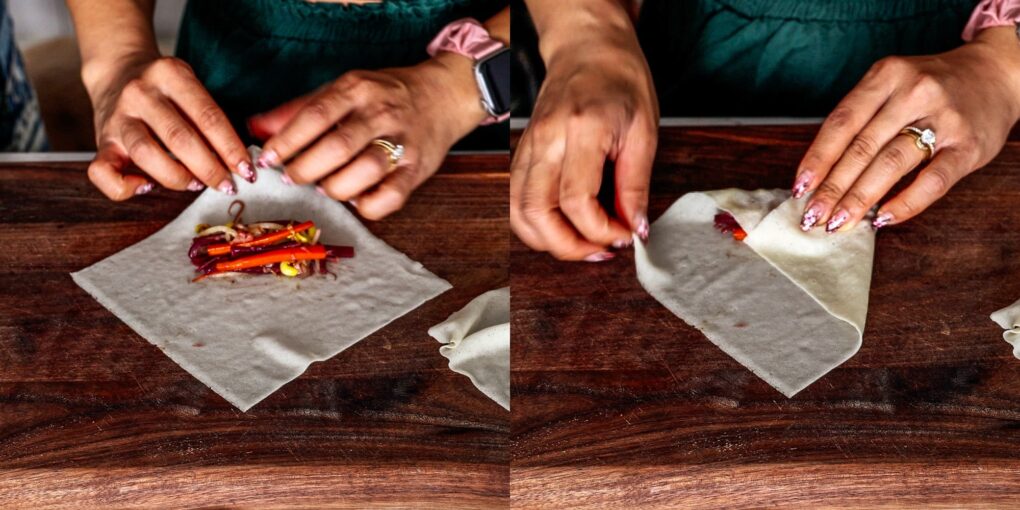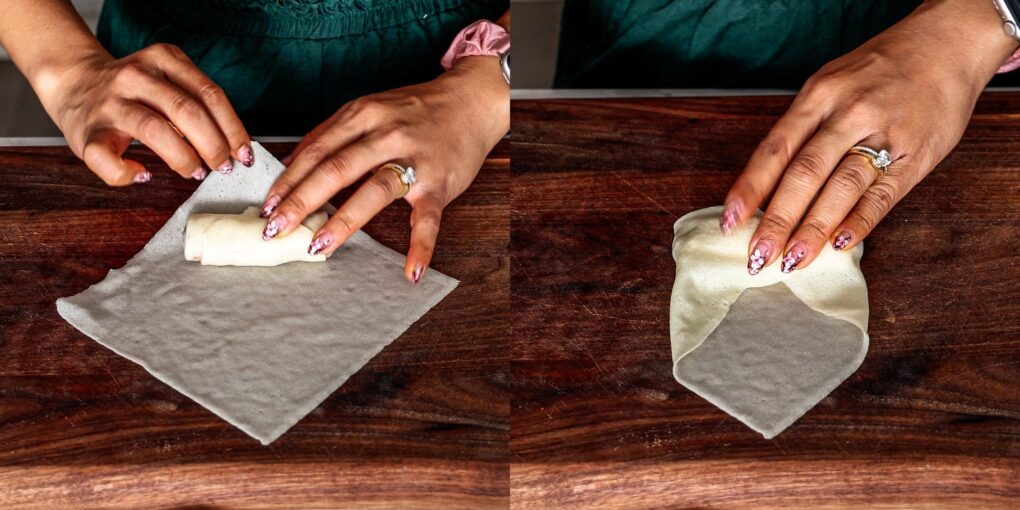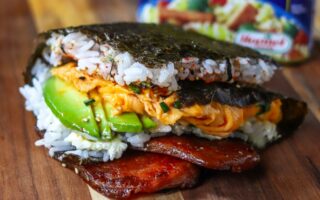
When you think of Filipino food, there’s a huge chance you picture a tray of lumpia or spring rolls served with sweet chili sauce. And while this version of a spring roll known as lumpiang shanghai is undoubtedly the most popular, its vegetable counterpart is the kind that my family is most famous for. My mom makes a tray of her lumpiang gulay, or vegetable spring rolls, for every family party and social gathering. They are even crispier than regular lumpiang shanghai since they get double wrapped, and also have the crunchiness of the vegetables inside. So what better way to celebrate Mother’s Day than to celebrate my mom and the recipe she is so proud of!

Lumpiang gulay can also be a lot more work than lumpiang shanghai. You have to julienne the vegetables, cook them, wait for them to cool, then wrap them in lumpia wrappers twice before frying, though you can also speed up the process by just blitzing all of the veggies in your food processor (something my mom now does in her older age). But this extra work means you can taste the extra love put into each and every spring roll, so make a big batch of these lumpiang gulay for your next gathering and get ready for the compliments to flow in.

Which vegetables are the best for lumpiang gulay?
While you can put pretty much whatever your heart desires, the primary veggies you’ll find in traditional lumpiang gulay are carrots, cabbage and bean sprouts. My family likes to add sweet potato for extra flavor and body, and I personally use purple sweet potato for even more sweetness and for their beautiful color. You can also add green beans, onion, chayote, water chestnuts, or bamboo shoots.
Are lumpiang gulay vegan?
While all of the vegetables and wrappers are vegan, oyster sauce is the main flavor driver in this recipe. Just substitute in vegetarian oyster sauce to make these vegan.

Can I add protein to lumpiang gulay?
Feel free to customize these as you wish! You can add firm tofu to make a variation called lumpiang togue, or do like my mom does and add some ground pork or chicken if you want it to be more substantial. You could also add dried shrimp in the mix to add extra umami.
What dipping sauce goes with lumpiang gulay?
It’s common in Filipino cuisine to pair fried foods with vinegar to balance the oiliness with acidity, and these lumpia are no exception. Filipino cane vinegar or coconut vinegar are ideal as they have a more subtle acidity than white or apple cider vinegar so it won’t be too acidic, allowing the flavors of your veggies to shine. They also have a natural sweetness that works well with the veggies in the lumpia, especially when you infuse the vinegar with garlic, birds eye chili and black pepper. If you like things salty, you could also add a splash of soy sauce to your spiced vinegar.

My Mom’s Lumpiang Gulay – Filipino Vegetable Spring Rolls
Ingredients
For the lumpia:
- 2 tbsp neutral oil
- 1 purple sweet potato, julienned or chopped in food processor
- 1 large carrot, julienned or chopped in food processor
- 1 napa or chinese cabbage, chopped
- 1.5 cups bean sprouts
- 3 cloves garlic, minced
- Salt to taste
- 4 tbsp oyster sauce or vegetarian oyster sauce, more to taste
- 1/2 tbsp sesame oil, more to taste
- 1 tsp white pepper, more to taste
- 1/2 tsp fresh ground black pepper, more to taste
- 24 spring roll or lumpia wrappers, thawed
- Vegetable or canola oil for frying
For the spiced vinegar dipping sauce:
- 1 clove crushed garlic
- 1 birds eye chili, chopped
- Few turns of fresh ground black pepper
- 4 tbsp cane vinegar or coconut vinegar
Instructions
- Heat oil in a wok or large skillet over medium high heat, and stir fry sweet potato and carrots with a pinch of salt until it begins to soften, about 5 minutes
- Add cabbage, bean sprouts, and garlic and stir fry for another 1-2 minutes until cabbage is wilted. Turn off heat.
- Add oyster sauce, sesame oil, white pepper, and fresh ground black pepper and mix until well-combined, adding more to taste if desired.
- Let the vegetables sit for 5 minutes while you start to peel and separate your wrappers. Then drain the vegetables in a colander or strainer and allow to cool.
- Wrap your lumpia. Begin by placing a wrapper in front of you in a diamond shape.
- Add a heaping spoonful of filling in the middle of the wrapper toward the bottom corner closest to you, then fold the bottom corner over the filling, rolling tightly away from you.
- Fold the left and right corners into the middle over the filling, then continue rolling tightly until you form a spring roll shape, using water to seal the top corner of the wrapper.
- Take a second wrapper and place it in front of you in a diamond shape. Place your wrapped lumpia horizontally toward the bottom corner of the wrapper, and follow the same steps to double wrap your lumpia to ensure you have crispy lumpia since the vegetables will soften your first wrapper. You can freeze the wrapped lumpia for later if desired.
- Preheat your oil for frying to 350F or until bubbles appear in the oil when you dip a wooden chopstick inside.
- In the meantime, make your spiced vinegar dipping sauce by combining the ingredients in a small bowl.
- Deep fry the lumpia until golden brown all over, then drain on a paper towel.
- Serve with spiced vinegar dipping sauce and enjoy!






